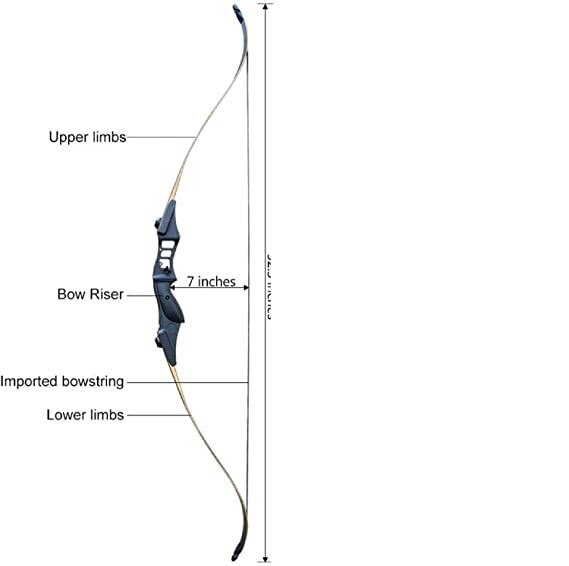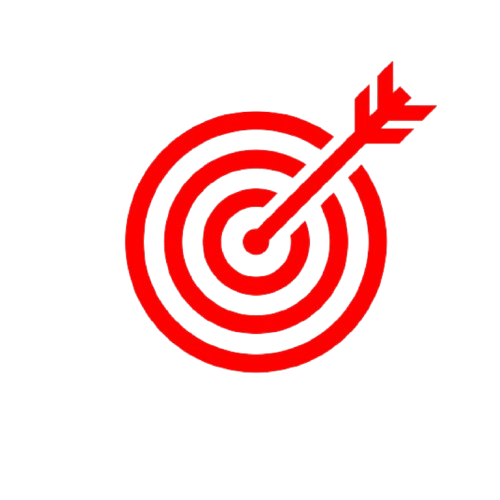An archer needs the idea of each part of a recurve bow in order to aim accurately and select the best recurve bow for beginners . Modern recurve bows are much more effective than conventional D-shaped bows. Their improved design and functionality make the user more confident.
Recurve bows are powerful and can shoot arrows faster. But shooting using these can be challenging and requires more practice, especially for beginners. Therefore, the detailed idea about each of these bow parts makes it easy to use.
We will discuss here each of the parts of the best archery bow for modern competitive archery. If you are interested in bows or want to be an archer, this article is for you, keep reading the details to find the best recurve bow for beginners.
Important parts and functionality of a best beginners recurve bow
There are 3 main parts of a recurve bow. They are-
- Riser– the base of the bow, from which the rest of the bow is made.
- Limbs– curve towards the archer and the end edge curved in the opposite direction from the archer.
- Bowstring– joins the two ends of the bow and launches the arrow.

The main parts of a recurve bow are described below.
1. Riser
This is the middle parts of a recurve bow, which can be called the heart of the recurve bow. The riser is the backbone of the bow that holds the limbs tightly and the other necessary elements attached. Usually, various manufacturers use aluminum to make it, but risers made of carbon fiber are equally effective.
The standard riser size of a recurve bow is 25 inches. If you combine it with the length of the limb, you get the bow length. A long limb with a 25-inch riser will give you a 70-inch bow. A medium pair limb will give you a 68-inch bow and a small pair limb will give you a 66-inch bow.
The Raiser combines clicker, arrow rest, v-bar, eyesight, etc that makes the target accurately. Below we will describe all parts of a recurve bow names and their functionality.
Clicker: It is usually used for a recurve bow and lets the archer know the bow has returned to the correct draw length or full draw. This important parts of a recurve bow gives an audible click and only at the sound of the clicker will the archer release his arrow.
A clicker wire can be a powerful part but is mostly made of tensile spring steel or a magnetic wire arm, or carbon. These are usually about 6.35 mm wide and 76.2 mm long and are attached to the riser by a screw.
It is mounted on the sight window or next to the riser. Where the upper part of the clicker is screwed or attached to the riser and the lower part of the clicker hangs towards the bottom of the arrow shelf.
Sight: It is the part attached to the riser with customizable screws that have different distance marks. The sight can help you create more consistent shots. These provide an adjustable pin to help the archer use the more accurate shots.
Everybody has to adjust the vision to the specific distance for which he wants to shoot. It is very important that you maintain proper eyesight because different people have different vision settings for certain distances.
Grip: The grip is one element that makes an excellent form of an archer. Poor grip technique and especially poor grip continuity can cause mistakes, tuning problems, big left and right miss, and even less draw on your grip. Adopting the right grip technique will make your time in practice more effective and enjoyable.
The grips depend on the angle of the bow. It makes it easy to shoot the bow accurately with more pressure on the top or bottom of the hand. Grip manufacturing companies often design for comfort and to match the archer’s hand. It is easy to replace the riser grips with others on the market.
Stabilizer system: This is the parts of a recurve bow that gives a balanced and smooth feeling of the bow during and after the shot. This system absorbs the vibrations of the bow and helps to reduce the unnecessary noise caused by the release of the arrow. This allows the archer to hold the bow in his fixed hand.
A stabilizer system is to comprise a long rod, a short rod, an extension rod, extra weight, and a V-bar. In addition, you can add a damper at the end of each rod to absorb vibrations or add extra weight as desired.
Too much stabilizer will affect your control over the bow. While they are very suitable for improving accuracy, they will not replace having an excellent strategy.
Mono rod: A lot of times you might pull the string back a bit more before releasing, which can bend a bit after the bow is released before the arrow is completely closed. As a result, the arrow is likely to miss the target.
You can use a mono rod stabilizer to deal with this problem and to stabilize the bow. You can add weight to it for stability if needed.
V-bar: This is one important parts of a recurve bow is stabilizer system. The V-bar is used to attach the small rod on the side to the main long rod of the stabilizer. It looks a lot like a V, from which it is named.
Arrow rest: It is the part where your arrow sits before the draw and during the run. This has a big impact on the accuracy and consistency of your shots. This accessory is small, but there is no reason to think it is trivial. Make sure you don’t overlook the importance of arrow rest when assembling your recurve bow components setup.
Arrow rests can be made with a variety of materials. They can be bolt-on or fastened and they come in different thicknesses to adjust the weight of fresh arrows.
There are many types of bow rest available in the market for recurve bows. These include shelf rests, stick-on rests, screw-in or bolt-on rests, and rest-plunger combos.
Plunger: It is one of the smallest parts of a recurve bow but most important tools of the recurve bow. These are also called cushion buttons which serve two purposes. First, it directs the arrow below the center of the bow during the shot.
The plungers also restrain the flexibility of the arrow after release. This is one of the most important parts of a recurve bow for beginners.
The plungers, which look like sparks, comprise a tube that covers a spring. These are allocated to the riser above the arrow rest, where the head contacts the arrow horizontally. You can adjust the arrow to the left or right of the center of the plunger to ensure the center shot.
These are important for competitive archers who make minor mistakes when dealing with stress and nerves. A properly adjusted plunger helps bring the arrow back to the middle, but it can’t fix horrible shots.
2. Limbs
Unlike some accessories such as sights and plungers, recurve bow limbs can change frequently. The learner changes limbs every year to move towards higher draw weights by mastering the technique.
Archers should use their entry-level limbs at this time. When they determine their preferred draw weight, they can use high-quality limbs.
Manufacturing companies usually make primary limbs from wood, foam, and fiberglass, and advanced limbs using wood, bamboo, foam, and carbon. Primary limbs typically range from $100 to $400, but advanced limbs can cost a lot higher. The main reason for the difference in price is the materials.
The process of production between primary and advanced limbs is the same, but the layer and gluing materials together differ slightly between the two classes of organs.
The bodyweight of the limb is related directly to the speed of the arrow that it can make. Light limbs shoot arrows faster than heavy limbs and the torsional stability of improved ones is much higher.
For shooting the arrow continuously after the arrow, a good amount of torsional stability is important.
The smoothness of the limbs through the clicker zone is a feature that top archers want. If they struggle to pull their arrows through the final millimeters, they will get tired in the long days of competition. Tired archers lose motor control and their shooting accuracy is likely to be damaged.
Although high-level archers look for a magnificent set of advanced limbs, their equipment does not determine their shooting level. Your tools don’t always matter, practice makes you perfect.
3. Bowstring
A bowstring transfers energy from the bow and leaves it on the arrow. It is an important parts of recurve bow equipment and requires maintenance and replacement to ensure increased use. Plant fibers and animal skins are used to produce bowstrings as parts of a traditional bow.
But today’s manufacturing companies make these using high-tech synthetic materials. These advanced fibers make bows shoot faster and more reliably and accurately. There are a few more things associated with Bowstring, below.
Bowstring serving: It is wrapped tightly around the bowstring. That is why a single cord is created and the arrow knock creates a consistent area to attach the arrow to the bowstring. Using the right bowstring serving string material for your bowstrings can increase your shooting performance.
Nock: The point of the bowstring at which you clip your arrow is called the nock. Each bowstring must have at least one nocking point. Most of the manufacturing companies produce nock from plastic, but they also make some to the nock using aluminum.
THERE ARE ALSO SOME MINOR PARTS OF RECURVE BOW AND ARROW YOU SHOULD KNOW.
Point: Archers use these narrow points for target practice, which they also call field points.
They come in a variety of types and materials with a variety of trade names such as Bullet Point, Blunt Point, Rubber Point, Stainless Steel, and others. This dull metallic edge provides weight to the front edge, allowing the arrow to fly into the air.
Armguard: An armguard is secured with permanent straps on the arm of the archer’s bow and most of the manufacturers usually make these of leather or plastic.
This provides protection from the bowstring during shooting a recurve bow as the stored energy is released through the arrow.
Bow sling: A strap made of cloth or leather, which is attached to the riser at the bottom of the grip. These are used to prevent the bow from slipping out of the archer’s hand. This gives them extra security and is wrapped around the archer’s wrist.
Fletching: Arrow fletching are available in many lengths and profiles, but feathers or plastic vanes are the most common type. These are attached to drive and stabilize the arrow after it has come out of the bow. These correct some slight errors that affect the flight of the arrow.
Quiver: It is a bag that is usually composed of leather, plastic, cloth, or synthetics to store the archer’s remaining arrows during shooting. Archers use it on the buttocks or on their shoulders.
Finger tab: It is a material made of leather that protects the fingers. The finger tab provides a smooth surface when it is released bowstring after pulling.
Clothing guard: It is used so that the archer’s clothing does not affect or interfere with the string in any way.
Bottom line
Creating the best quality recurve bow requires the incorporation of the best quality parts. We have given here the details of all the corresponding parts of a recurve bow. Hope this parts of a recurve bow explained will help you.
However, Recurve bows are best for beginners because it is very simple to use than the compound bows and crossbows.

Leave a Reply